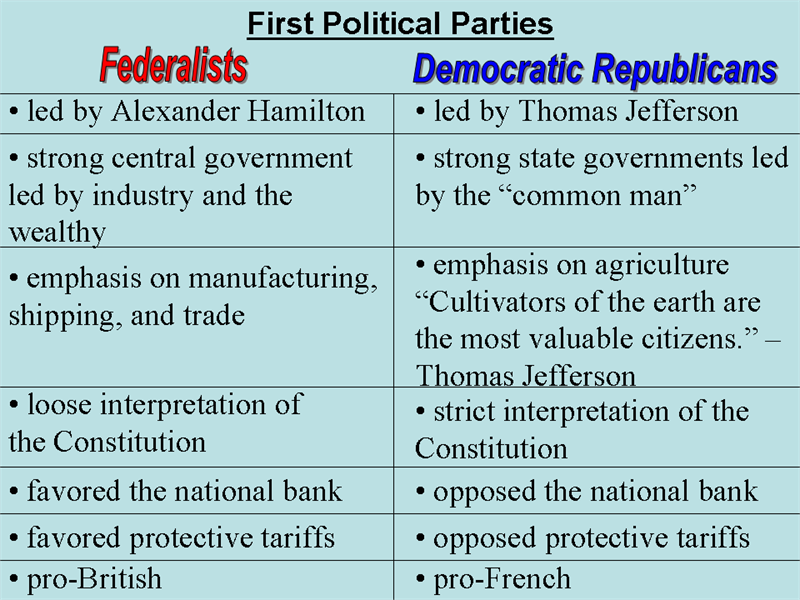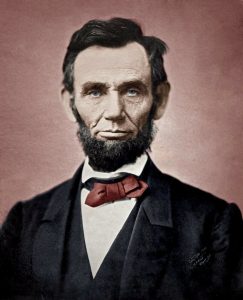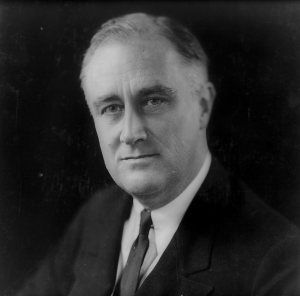9.2: The Historical Development of U.S. Political Parties
- Page ID
- 134565
“Americans want a politics they don’t have to hate. And therein lies our hope: Democracies are uniquely open to change, and if citizens want politicians to move beyond false choices, it is in their power to demand it.”
–E. J. Dionne, Jr. (1)
In his farewell address, President George Washington warned against political parties, particularly those based on geographic loyalties. He went on to say that partisanship “serves always to distract the public councils and enfeeble the public administration. It agitates the community with ill-founded jealousies and false alarms; kindles the animosity of one part against another; foments occasionally riot and insurrection. It opens the door to foreign influence and corruption, which finds a facilitated access to the government itself through the channels of party passion.” (2) Nevertheless, political parties became entrenched in the political system.
Beginnings of the Party System
Party struggles really began within the Washington administration. Two predominate parties emerged, the Federalists and Democratic-Republicans. The Federalists initially had the upper hand in early party competition, selecting John Adams to replace Washington in 1797. But the Democratic-Republicans came charging back with Jefferson’s two-term administration beginning in 1801, James Madison’s two terms, and James Monroe’s two terms ending in 1825. The Federalists quickly faded from the scene.

Source: UShistoryvocab
Democrats and Whigs in the Antebellum Period
With the Federalists fading, the Democratic-Republicans were the only game in town. Soon, disagreements arose and the party split into two groups: Democrats, which have continued to the present day, and the National Republicans, which then became the Whig Party that eventually dissolved over slavery in the 1850s. It was the Whigs, not the Democrats, who believed in using the central government’s power to make “internal improvements” to the country such as roads and canals. The Democrats were the party of the “common man,” which is still its reputation.
The Civil War Crisis

The American party system was rocked by the crisis over slavery and states’ rights that resulted in the Civil War. The Whig party split into a Northern wing that held on to the principles of an active central government, and a Southern wing whose members were concerned that a central government powerful enough to make “internal improvements” was powerful enough to end slavery. Although the Democrats were also split between North and South, that party survived whereas the Whig party completely disintegrated.
In the mid-1850s, northern Whigs joined some antislavery Democrats and members of the Free Soil Party to create the modern Republican Party. Early Republicans were mobilized when the Kansas-Nebraska Act passed, which overturned the Missouri Compromise of 1820, and allowed new territories to permit slavery if they wanted. They envisioned a land free from slavery and wage slavery—meaning the business exploitation of for-hire laborers. Autonomous workers were celebrated—primarily independent farmers and the self-employed. Meanwhile, capitalists feared, regardless of whether they were plantation owners in the South or factory owners in the North.
Alvan Bovay was one of the people who initiated the push to establish the Republican Party in 1854. He worked on a number of radical causes, including a “vote yourself a farm” campaign, and wrote for George Evans’ Working Man’s Advocate and Young America newspapers. Abraham Lincoln, the Republican’s second presidential candidate, won the very divided election of 1860 with only 40 percent of the popular vote. The land reform that Bovay and Evans advocated in the 1850s was supported by Lincoln and became the Homestead Act of 1862, which distributed land in the West to settlers who would “improve” it. (3) With the demise of the Whig Party, the Republicans and Democrats became the pre-eminent political parties in U.S. politics to this day.
Republican Dominance
From the Civil War to the Gilded Age , Republicans dominated the presidency and often enjoyed Republican majorities in the House and Senate. The Republicans dropped any hint of “red republicanism” and evolved into a party that promoted business interests and economic growth, pushed public schools that produced the standardized graduates that business leaders needed, endorsed the gold standard that promoted price stability that business leaders wanted, and supported high tariffs on imports that protected U.S. manufacturers. During this period of Republican dominance, wealth and income inequality grew to obscene levels that were fueled by monopoly capitalism.
The Democrats maintained a stronghold in the South and strong support among Northern-city Catholic immigrants and small Mid-western farm owners. Later, the South became known as the Solid South because Democrats dominated until after the mid-1960s when Republicans began to rise. Populism gripped the Democratic Party in the late 1890s. But in the election of 1896, the Republicans’ huge financial advantage and victories in the Electoral College-rich Northeastern states kept the Democrats out of the White House.
The spirit of progressivism infected both parties in the early 1900s, but it created the most lasting impression on the Democratic Party. In the 1912 election when Republicans split between William Howard Taft and Theodore Roosevelt, Woodrow Wilson became president, and the Democrats began to embrace many progressive ideals—using government to solve social problems, controlling the power of large business interests, and instituting social reforms such as extending the right to vote and banning child labor.
The New Deal Coalition

The Great Depression began with the stock market crash in October 1929 and marked the death knell for Republicans' long-held dominance of national politics. Many people were convinced that President Herbert Hoover’s conservative response to the crisis was insufficient. The 1932 election brought Democrat Franklin Roosevelt to power–the only president to win election four times–and his administration used the government’s power to alleviate suffering, regulate the economy, and put people back to work. Known as the New Deal, the overall policy included such features as Social Security, unemployment insurance, the Securities and Exchange Commission, the Federal Deposit Insurance Corporation, the Tennessee Valley Authority, the Civilian Conservation Corps, and the Works Progress Administration, among many others. The Democrats dominated national politics from 1933 to the end of the 1960s, largely because of what has become known as the New Deal Coalition, which included white Southerners, unionized workers, farmers, Jews, white-collar professionals, African-Americans, and urban immigrants who were predominantly Catholics. The New Deal programs were popular enough that the Republican Eisenhower administration left them in place in the 1950s, and the Democratic Johnson administration built on them in the 1960s.
Contemporary Party Struggles
The success of the Civil Rights Movement, the cultural turmoil of the late 1960s, and the stridency of the Democratic party’s anti-Vietnam War wing fractured the New Deal coalition and hurt many Democratic candidates’ electoral chances. By the early 1970s, the Republicans became increasingly successful in attracting support from whites opposed to racial desegregation, from men and women who were disconcerted by women’s liberation, from rural voters concerned about gun control, and from voters who disdained the perception of pacifism in American foreign policy. Moreover, the Roe v. Wade (1973) decision legalizing abortion and the rise of the gay rights debate handed Republicans two social issues that were instrumental in courting Catholics, evangelical Protestants, and Mormons.
Beginning in the 1960s, Republicans pursued what most people call the Southern Strategy—a conscious and largely successful attempt to capture the South by playing on white’s fears of the Civil Rights movement. This strategy linked the South with suburban and rural areas across the United States, aimed at white fears of racial integration, urban crime, and economic insecurity. The Republican party also embraced an assault on public schools at the behest of religious conservatives opposed to school integration and the teaching of evolution.
The Southern Strategy was successful. The Democrat’s Solid South transformed to become a bastion of Republican office holders instead. Republicans won eight of the thirteen presidential elections from 1968 to 2016 and wrested both congressional chambers from Democrat control. Similarly, Republicans dominated state gubernatorial and legislative elections in 2010, which allowed them to gerrymander district boundary lines to their advantage. In 2020, the country was in the midst of the Covid-19 Pandemic, which also happened to be the same year that the census occurred. It's not entirely clear how accurate the counting of the population was, but the Republicans used the information to gerrymander to their advantage yet again.
Meanwhile, the Democratic party increasingly turned to the same sources as the Republicans to fund its candidates—corporations and the wealthy—and it pursued policies that were often indistinguishable from the Republicans. Still socially liberal, the Democratic party became controlled by the New Democrats, who are often referred to as the Corporate Democrats because of their connections with and deference to large corporations.
Progressive members of the Democratic Party were reignited with democratic-socialist Bernie Sanders' failed attempt to gain the Democratic presidential nomination in 2016. His candidacy in 2016 and again in 2018 underscored the deep divisions in the Democratic party between its corporate and progressive wings.
Third or Minor Parties
According to the Public Broadcast Services, there were more than 54 political parties in the United States in 2021. The Green Party, Reform Party, Libertarians, Constitution Party, and Natural Law Party represent the most active third parties currently in the United States. All of these parties have fielded presidential candidates in the last several elections.
The most successful of the third parties in any one election was the Reform Party, which in 1992 nominated Texas billionaire Ross Perot as its candidate for president. Perot ran on a platform that advocated reducing the federal budget deficit, an issue previously ignored in elections but one that would become a major part of almost every presidential campaign since. Perot received 19 percent of the vote.
Third parties often organize around a single personality or a single issue and that can lead to less popularity among voters. Current federal campaign finance laws, rules that dictate who can enter presidential debates, and a lack of media attention are elements that put these parties at a disadvantage. However, perhaps the most significant of the obstacles facing candidates is the winner-take-all system. In most states, the presidential candidate with the highest percentage of votes gets all the state’s electoral votes.
References
- E. J. Dionne, Jr., Why Americans Hate Politics. New York: Simon & Schuster, 1991. Page 373.
- George Washington, Farewell Address, September 19, 1796. The National Archives.
- Lance Selfa, The Democrats: A Critical History. Revised and Updated Edition. Chicago: Haymarket Books, 2008. Pages 63-85.
- Matt Taibbi, “Obama and Jobs: Why I Don’t Believe Him Anymore,” Common Dreams. September 6, 2011.
- Michael Lewis, The Big Short: Inside the Doomsday Machine. New York: W.W. Norton & Company, 2010. Matt Taibbi, Griftopia: A Story of Bankers, Politicians, and the Most Audacious Power Grab in American History. New York: Random House, 2010.
Media Attributions
- Lincoln © casually cruel is licensed under a CC BY-NC-ND (Attribution NonCommercial NoDerivatives) license
- Roosevelt © Executive Office of the President is licensed under a Public Domain license

